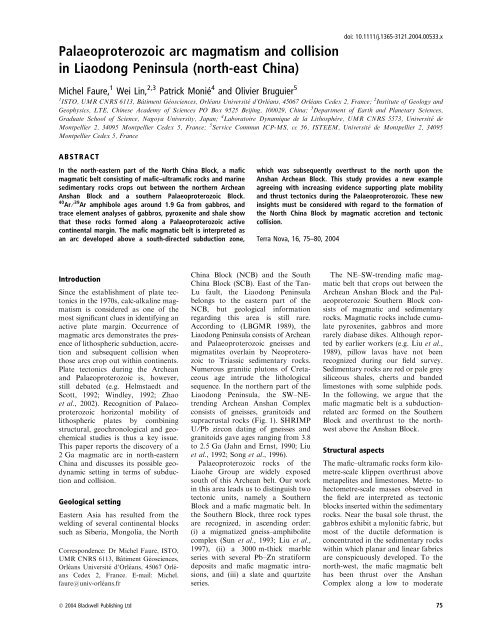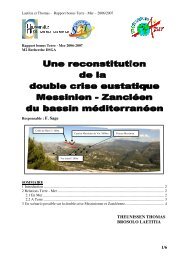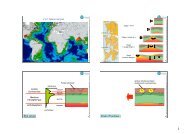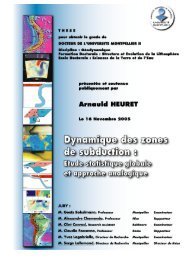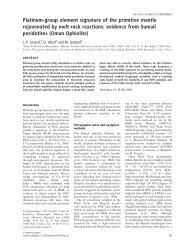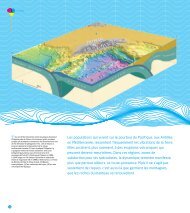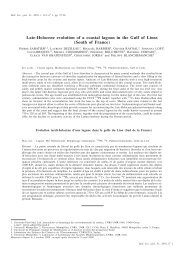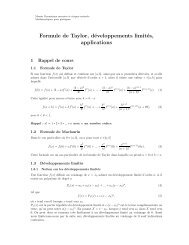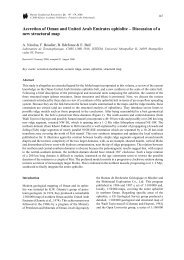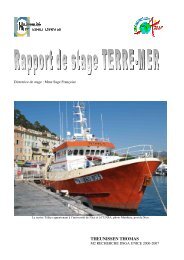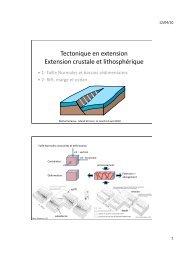Géochronologie U-Pb par ablation laser et ICP-MS (LA-ICP-MS ...
Géochronologie U-Pb par ablation laser et ICP-MS (LA-ICP-MS ...
Géochronologie U-Pb par ablation laser et ICP-MS (LA-ICP-MS ...
You also want an ePaper? Increase the reach of your titles
YUMPU automatically turns print PDFs into web optimized ePapers that Google loves.
Palaeoproterozoic arc magmatism and collision<br />
in Liaodong Peninsula (north-east China)<br />
doi: 10.1111/j.1365-3121.2004.00533.x<br />
Michel Faure, 1 Wei Lin, 2,3 Patrick Monié 4 and Olivier Bruguier 5<br />
1 ISTO, UMR CNRS 6113, Baˆtiment Ge´osciences, Orle´ans Universite´ d’Orle´ans, 45067 Orle´ans Cedex 2, France; 2 Institute of Geology and<br />
Geophysics, LTE, Chinese Academy of Sciences PO Box 9525 Beijing, 100029, China; 3 De<strong>par</strong>tment of Earth and Plan<strong>et</strong>ary Sciences,<br />
Graduate School of Science, Nagoya University, Japan; 4 Laboratoire Dynamique de la Lithosphe`re, UMR CNRS 5573, Universite´ de<br />
Montpellier 2, 34095 Montpellier Cedex 5, France; 5 Service Commun <strong>ICP</strong>-<strong>MS</strong>, cc 56, ISTEEM, Universite´ de Montpellier 2, 34095<br />
Montpellier Cedex 5, France<br />
ABSTRACT<br />
In the north-eastern <strong>par</strong>t of the North China Block, a mafic<br />
magmatic belt consisting of mafic–ultramafic rocks and marine<br />
sedimentary rocks crops out b<strong>et</strong>ween the northern Archean<br />
Anshan Block and a southern Palaeoproterozoic Block.<br />
40 Ar ⁄ 39 Ar amphibole ages around 1.9 Ga from gabbros, and<br />
trace element analyses of gabbros, pyroxenite and shale show<br />
that these rocks formed along a Palaeoproterozoic active<br />
continental margin. The mafic magmatic belt is interpr<strong>et</strong>ed as<br />
an arc developed above a south-directed subduction zone,<br />
which was subsequently overthrust to the north upon the<br />
Anshan Archean Block. This study provides a new example<br />
agreeing with increasing evidence supporting plate mobility<br />
and thrust tectonics during the Palaeoproterozoic. These new<br />
insights must be considered with regard to the formation of<br />
the North China Block by magmatic accr<strong>et</strong>ion and tectonic<br />
collision.<br />
Terra Nova, 16, 75–80, 2004<br />
Introduction<br />
Since the establishment of plate tectonics<br />
in the 1970s, calc-alkaline magmatism<br />
is considered as one of the<br />
most significant clues in identifying an<br />
active plate margin. Occurrence of<br />
magmatic arcs demonstrates the presence<br />
of lithospheric subduction, accr<strong>et</strong>ion<br />
and subsequent collision when<br />
those arcs crop out within continents.<br />
Plate tectonics during the Archean<br />
and Palaeoproterozoic is, however,<br />
still debated (e.g. Helmstaedt and<br />
Scott, 1992; Windley, 1992; Zhao<br />
<strong>et</strong> al., 2002). Recognition of Palaeoproterozoic<br />
horizontal mobility of<br />
lithospheric plates by combining<br />
structural, geochronological and geochemical<br />
studies is thus a key issue.<br />
This paper reports the discovery of a<br />
2 Ga magmatic arc in north-eastern<br />
China and discusses its possible geodynamic<br />
s<strong>et</strong>ting in terms of subduction<br />
and collision.<br />
Geological s<strong>et</strong>ting<br />
Eastern Asia has resulted from the<br />
welding of several continental blocks<br />
such as Siberia, Mongolia, the North<br />
Correspondence: Dr Michel Faure, ISTO,<br />
UMR CNRS 6113, Bâtiment Géosciences,<br />
Orléans Université d’Orléans, 45067 Orléans<br />
Cedex 2, France. E-mail: Michel.<br />
faure@univ-orle´ ans.fr<br />
China Block (NCB) and the South<br />
China Block (SCB). East of the Tan-<br />
Lu fault, the Liaodong Peninsula<br />
belongs to the eastern <strong>par</strong>t of the<br />
NCB, but geological information<br />
regarding this area is still rare.<br />
According to (LBGMR 1989), the<br />
Liaodong Peninsula consists of Archean<br />
and Palaeoproterozoic gneisses and<br />
migmatites overlain by Neoproterozoic<br />
to Triassic sedimentary rocks.<br />
Numerous granitic plutons of Cr<strong>et</strong>aceous<br />
age intrude the lithological<br />
sequence. In the northern <strong>par</strong>t of the<br />
Liaodong Peninsula, the SW–NEtrending<br />
Archean Anshan Complex<br />
consists of gneisses, granitoids and<br />
supracrustal rocks (Fig. 1). SHRIMP<br />
U ⁄ <strong>Pb</strong> zircon dating of gneisses and<br />
granitoids gave ages ranging from 3.8<br />
to 2.5 Ga (Jahn and Ernst, 1990; Liu<br />
<strong>et</strong> al., 1992; Song <strong>et</strong> al., 1996).<br />
Palaeoproterozoic rocks of the<br />
Liaohe Group are widely exposed<br />
south of this Archean belt. Our work<br />
in this area leads us to distinguish two<br />
tectonic units, namely a Southern<br />
Block and a mafic magmatic belt. In<br />
the Southern Block, three rock types<br />
are recognized, in ascending order:<br />
(i) a migmatized gneiss–amphibolite<br />
complex (Sun <strong>et</strong> al., 1993; Liu <strong>et</strong> al.,<br />
1997), (ii) a 3000 m-thick marble<br />
series with several <strong>Pb</strong>–Zn stratiform<br />
deposits and mafic magmatic intrusions,<br />
and (iii) a slate and quartzite<br />
series.<br />
The NE–SW-trending mafic magmatic<br />
belt that crops out b<strong>et</strong>ween the<br />
Archean Anshan Block and the Palaeoproterozoic<br />
Southern Block consists<br />
of magmatic and sedimentary<br />
rocks. Magmatic rocks include cumulate<br />
pyroxenites, gabbros and more<br />
rarely diabase dikes. Although reported<br />
by earlier workers (e.g. Liu <strong>et</strong> al.,<br />
1989), pillow lavas have not been<br />
recognized during our field survey.<br />
Sedimentary rocks are red or pale grey<br />
siliceous shales, cherts and banded<br />
limestones with some sulphide pods.<br />
In the following, we argue that the<br />
mafic magmatic belt is a subductionrelated<br />
arc formed on the Southern<br />
Block and overthrust to the northwest<br />
above the Anshan Block.<br />
Structural aspects<br />
The mafic–ultramafic rocks form kilom<strong>et</strong>re-scale<br />
klippen overthrust above<br />
m<strong>et</strong>apelites and limestones. M<strong>et</strong>re- to<br />
hectom<strong>et</strong>re-scale masses observed in<br />
the field are interpr<strong>et</strong>ed as tectonic<br />
blocks inserted within the sedimentary<br />
rocks. Near the basal sole thrust, the<br />
gabbros exhibit a mylonitic fabric, but<br />
most of the ductile deformation is<br />
concentrated in the sedimentary rocks<br />
within which planar and linear fabrics<br />
are conspicuously developed. To the<br />
north-west, the mafic magmatic belt<br />
has been thrust over the Anshan<br />
Complex along a low to moderate<br />
Ó 2004 Blackwell Publishing Ltd 75


